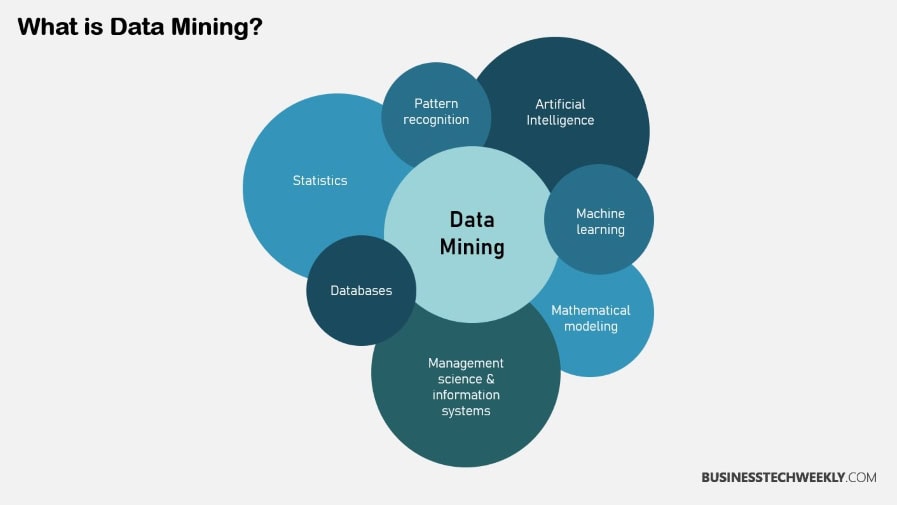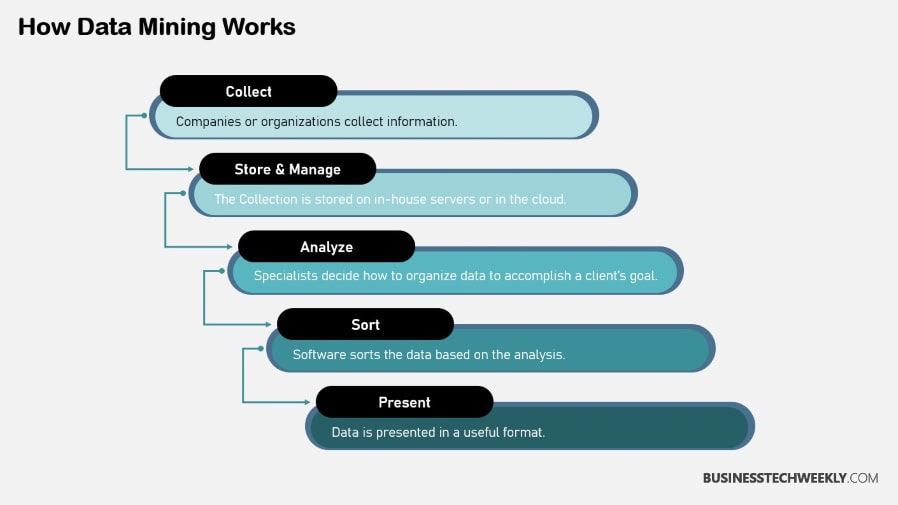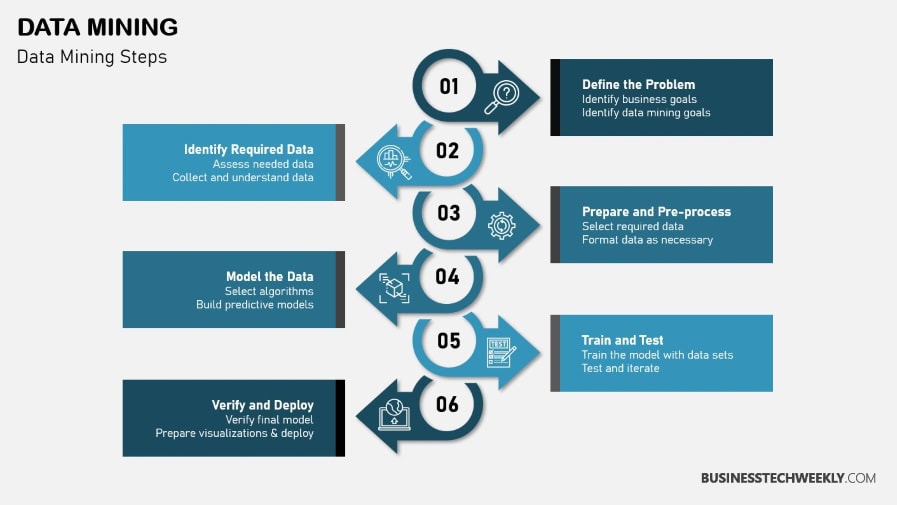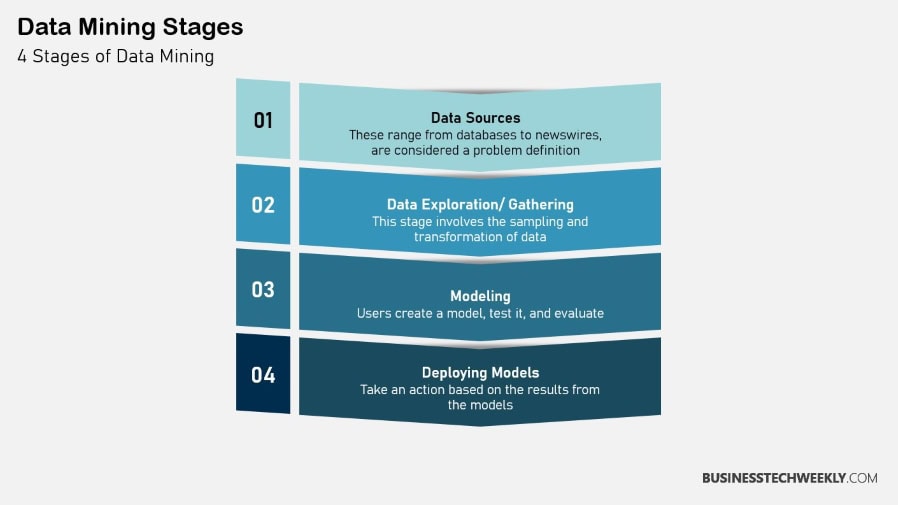Data Mining Solutions: Leveraging Data for Business Success

On this page:
What Are Data Mining Solutions?
Data mining solutions are some of the most useful tools and processes to help you glean useful insights from massive datasets.
These solutions help organizations turn raw data into meaningful business intelligence so they can make more informed decisions.
These projects take on essential roles in every sector. By locating patterns, trends, and correlations, they guide companies to create smarter business strategies.
1. Definition and Overview
Data mining is a computational process that uses algorithms to discover and extract valuable patterns and trends from large data sets.
You use descriptive modeling on historical data to understand what has happened.
Finally, apply prescriptive modeling to prescribe what you should do in the future considering your internal and external variables.
Automation is an important factor in improving efficiency, enabling faster and more accurate data analysis.
For instance, K-nearest neighbor (KNN) algorithms – often used in diagnostic predictions—classify data points according to their nearest neighbors, simplifying complex decision-making processes.
Data mining solutions’ seamless integration into business intelligence (BI) and analytics suites offers an all-encompassing perspective that’s essential to mastering data-driven strategies.
Advanced data mining tools play a pivotal role in extracting valuable insights from large and complex datasets, enabling organizations to uncover hidden patterns, trends, and correlations that can drive business success.
2. Importance in Various Industries
The versatility of data mining solutions is shown by their use in a variety of industries.
In healthcare, these tools make sense of patient data to optimize treatment options, enabling more effective and efficient care delivery. The finance industry uses data mining to predict risk and detect fraud, keeping our financial systems secure and stable. Retail companies employ data mining solutions to gauge consumer habits and preferences, keep their shelves stocked with the right products, and customize their stores to fit what people want.
Industries from advertising to manufacturing to supply chain management flourish with these solutions. They optimize fleet deployment and enhance asset management.
3. Key Benefits and Advantages
Data mining solutions provide many benefits that, as a result, lead to better decision-making and increased operational effectiveness.
By uncovering market trends and customer preferences, organizations can better develop strategies to address these changing needs.
Data mining solutions also enable organizations to achieve cost savings by identifying the most-effective resource allocation, maximizing business potential. They can analyze unstructured data, which makes up 90 percent of the digital universe.
Even with caveats such as lack of clarity on results, the value of data mining to support smart, data-driven planning and foster equitable, sustainable growth is significant.
RELATED: Harnassing Unstructured Data for Business Insights

Types of Data Mining Services
Data mining services has come along way to suit the varied needs of businesses from different industry verticals.
They’re an essential component to realizing valuable insights from complex, voluminous data sets. This versatility and flexibility make them an indispensable part of today’s data analytics landscape.
You can access a variety of services. These types of services range from predictive analytics that can predict future trends and outcomes to customer segmentation that groups customers by common attributes.
These services are used in industries including financial services, public health, advertising, and logistics.
Consulting organizations like IBM, Microsoft, and Oracle also provide tailored solutions. These options provide organizations with the flexibility to use data mining in ways that best serve their industry-specific requirements.
Selecting the appropriate type of service is important for making progress toward your organization’s goals. It ensures that the insights you obtain are not only actionable but also relevant.
Social Media Data Analysis
Social media data analysis is an incredibly powerful tool to grasp consumer sentiment. Brand monitoring is a key aspect of this analysis. Businesses use data mining techniques to monitor the state of their brand.
They keep an eye on what competitors are doing over on Twitter, Instagram, and more.
This analysis allows businesses to tailor their marketing approaches, giving them up-to-date knowledge about what consumers want and the current trends at play. For example, the effectiveness of a campaign can be measured in a matter of days, enabling swift corrections to be made.
SQL Data Processing
SQL data processing is an important part of working with and querying relational databases.
It supports data mining by allowing fast access to data and data processing, which is very important for an in-depth analysis.
SQL’s versatility in unifying multiple data sources gives you a complete view of your data, leading to more informed, data-driven decisions.
This feature is a huge asset to industries like finance and healthcare, where data accuracy and integrity are critical.
Image Data Solutions
Image data solutions leverage data mining techniques to find patterns and recognition in the visual data.
In healthcare—just one example—these solutions are used in medical imaging analysis, assisting physicians with more accurate diagnosis of medical conditions.
This is where advanced algorithms come into play, helping to extract meaningful insights from massive image datasets.
They enable private and public sectors to better understand the world through visual data. This strategy is similarly adopted in other fields such as manufacturing, where image data analysis improves quality control processes.
Excel Data Techniques
Excel is still the go-to tool for introductory and everyday data mining tasks and analyses, particularly in the small and medium-sized enterprise.
In addition, its functions and features facilitate powerful data visualization and reporting, furthering its usability for both advanced and novice users.
Consider Excel as a key data management and visualization tool. Excel is a valuable, flexible tool to organize and analyze data.
Its growing popularity speaks to its value in enabling data-informed decisions in an accessible, simple, and efficient way.

Steps in Data Mining Process
Data mining is a systematic, semi-automated process that transforms raw data into useful information. We leverage these insights to bring critical context to the table and inform decision-making.
Though an overarching goal of the process is to obtain actionable insights, this process consists of several critical steps, each step building upon the previous one.
Here’s a detailed look at each step involved in data mining:
-
Define Business Goals
-
Analyze and Understand Data
-
Prepare and Cleanse Data
-
Develop Analytical Models
-
Evaluate and Validate Outcomes
-
Implement Changes and Monitor Progress
1. Define Business Goals
Defining clear business goals is the bedrock of any data mining project. Specific goals give you the direction you need to choose the right data sources and analytical methods to answer your questions.
For instance, if your goal is to boost sales through personalized recommendations, the data mining should focus on customer behavior and purchase history, aligning with the broader business strategy.
This strategic alignment makes certain the mining projects advance the business needs and community development.
2. Analyze and Understand Data
Exploratory Data Analysis (EDA) becomes the cornerstone for grasping the dataset’s intricacies and revealing the first inklings of insights.
This phase also addresses data quality issues and potential biases, which is important for building accurate and trustworthy models.
Data visualization tools also assist with illustrating complex relationships within the data, making it easier to visualize correlations and trends.
For instance, visualization may expose customer clusters based on buying behavior, helping to inform the next steps in the data mining process.
3. Prepare and Cleanse Data
Data preparation involves several critical tasks to ensure the dataset is ready for analysis:
-
Data extraction from various sources
-
Data transformation to achieve consistency
-
Data loading into appropriate formats
-
Data cleansing to remove inaccuracies
During this phase, standard data preparation processes such as outlier detection and the K-Nearest Neighbor (KNN) algorithm can further clean the data.
These steps help to make certain that the dataset is precise and coherent, creating a reliable base for model development.
4. Develop Analytical Models
Choosing the right statistical and machine learning models are key to successfully exploring data. Models such as decision trees and various clustering techniques assist in discovering patterns and insights from the data.
Training and validation of these models help make sure they are both performing accurately and reaching the desired objectives.
For example, clustering can classify customers into distinct categories according to their purchasing patterns, providing focused marketing possibilities.
RELATED: Statistical and machine learning models
5. Evaluate and Validate Outcomes
Measuring performance of models created is about comparing results with the business objectives established.
Validation techniques are critical in establishing the reliability of findings, making sure that the insights are useful and can be acted upon.
Internal feedback loops push for ongoing model development and improvement. They also allow for continuous improvement as new data and business conditions are introduced, maintaining the model’s relevance and effectiveness.
6. Implement Changes and Monitor Progress
Translating these data insights into actionable strategies is the main objective of data mining.
Continual tracking of changes made lets you know how things are working, and you can change strategies as needed based on real-time analysis.
By providing more relevant recommendations, eBay’s model increases customer satisfaction and also sales. It is less about the data and more about changing course as needed in real time to drive the best outcomes.

Tools and Techniques in Data Mining
Data mining is a key innovation for businesses fighting to survive in today’s rapidly evolving market space.
It powers predictive analytics and business intelligence, revolutionizing how organizations gain insights from their data.
Here’s a list of popular tools and techniques used in data mining:
-
Decision Trees for Analysis
-
Association Rule Learning
-
Clustering Methods Overview
-
Classification Techniques Explained
-
K-Nearest Neighbors Method
-
Neural Networks Applications
Decision Trees for Analysis
Decision trees provide a simple, visual representation of decision paths, making them an intuitive and easily interpretable option for classification tasks.
They fly high by reducing complicated, nuanced decisions into black-or-white, right-or-wrong, yes-or-no choices.
This method not only improves analysis comprehension, but also makes it easier to present findings to non-technical stakeholders.
Decision trees are especially valuable for their interpretability that enables stakeholders to understand the reasoning behind every decision made.
For instance in a sales prediction model, a decision tree provides an easily understandable visual representation.
It also shows which factors like customer age and purchase history most impact what will happen next.
Association Rule Learning
Association rule learning identifies relationships between data points, using if-then statements to uncover patterns.
This technique is pivotal in market basket analysis, where it reveals consumer purchasing trends.
Understanding these patterns helps businesses tailor marketing strategies to consumer preferences.
Support and confidence metrics are crucial in evaluating these rules, ensuring the reliability of the insights gained.
For instance, a supermarket might find that customers who buy bread are likely to also purchase butter, informing inventory and promotion strategies.
Clustering Methods Overview
Clustering clusters like data points without prior knowledge of the groups, making it invaluable in fields such as customer segmentation and market research. It helps companies find natural clusters in their data, which is extremely helpful for honing in on targeted marketing and product development.
Choosing the appropriate clustering algorithm is critical since it needs to fit the particular data type and business objective.
A travel agency, for instance, might utilize clustering to group customers together based on their travel habits, maximizing targeted marketing campaigns.
RELATED: Customer segmentation and market research
Classification Techniques Explained
Among these tools, classification techniques assign data into predefined classes and are frequently the focus of data mining efforts. Popular algorithms are logistic regression and support vector machines, among others, that are best tailored to specific classification tasks.
Using metrics such as accuracy and precision to evaluate these models is critical to making sure they work.
This is extremely important in high stakes applications, such as spam detection, where misclassifying a user’s email could drastically affect the user’s experience.
K-Nearest Neighbors Method
The K-Nearest Neighbors (KNN) method is a simple but versatile classification technique. It further classifies data based on their closeness, using distance metrics to identify their similarity to one another.
This approach is especially beneficial for multi-class classification tasks, providing flexibility and ease of implementation.
For example, in a handwriting recognition system, KNN can identify the letters by comparing their features and finding the closest match.
Neural Networks Applications
Neural networks are becoming increasingly popular due in part to their success in tackling complex data mining tasks.
They are great at understanding patterns based on massive datasets, getting better and better with time to make more precise predictions.
Their applications span across industries, including image recognition, natural language processing, and more, propelling innovation in areas such as healthcare and autonomous driving.
In the health sector, for instance, neural networks can be used to scan medical images and identify abnormalities, thereby helping in the early diagnosis of diseases.

Benefits of Outsourcing Data Mining
Outsourcing data mining services comes with a variety of benefits that can help improve your organization’s bottom line.
Here’s a closer look at the benefits:
-
Enhanced Efficiency and Accuracy
-
Cost-Effective Solutions
-
Access to Expert Knowledge
Enhanced Efficiency and Accuracy
Outsourcing data mining allows you to leverage specialized expertise for better outcomes.
Through this collaboration, you have access to targeted strategies that maximize efficiency.
In addition, specialized data mining teams can turn around projects more quickly, letting you rush in projects with short deadlines and win more work.
With professional data management practices creating a data environment with fewer errors, you can be confident the data you are working off of is accurate and trustworthy.
For example, Ascentrik can deliver custom lists, built around your unique criteria.
This strategy allows you to make better, more informed decisions, as well as deliver more value to your customers.
Cost-Effective Solutions
Managing in-house data mining teams can be a challenge, resulting in overhead costs. By outsourcing, you are able to reduce these costs dramatically.
Outsourcing arrangements are a flexible resource as well, providing the ability to ramp resources up or down based on your requirements without a significant long-term investment.
It’s a smarter, more cost-efficient approach that allows you to leverage sophisticated technologies without making a huge upfront investment – transforming big data into big strategic advantages.
The demand for data mining services is expected to increase by 20% in the next five years.
To preserve profitability in a high-cost environment, outsourcing will be a more attractive solution.
Access to Expert Knowledge
By working with seasoned data mining professionals you’ll gain access to priceless industry knowledge. These experts are constantly learning and keeping up with the latest techniques and tools, so your data mining processes will always be top of the line.
Collaborating with these data experts drives internal innovation and helps you deliver solutions that improve your overall business operations.
Outsourcing allows you to focus on your primary mission and goals.
That method increases efficiency and accelerates innovation, all while eliminating the hassle of overseeing an internal staff.
The data mining tools market is is expected to be valued at $1.24 billion in 2024, anticipated to reach $3.73 billion by 2034.
Applications of Data Mining Solutions
Data mining solutions lie at the heart of multiple industries, providing priceless knowledge for companies to prosper. Here are some key applications:
-
Retail Sales Pattern Analysis
-
Identifying Money Laundering Activities
-
Targeting DNA Sequences in Pharma
-
Sales and Marketing Optimization
-
Fraud Detection Strategies
Retail Sales Pattern Analysis
In retail, data mining helps organizations identify sales trends in each region. This knowledge allows retailers to make better decisions about what products people want and where people are wanting to find them.
With this knowledge, businesses can optimize their inventory to make sure fast-moving items are available when needed.
Through a deeper understanding of customer preferences, retailers can focus their marketing efforts on particular demographics, creating a more individualized experience for customers.
For instance, a clothing retailer might leverage data mining to identify rising fashions in different markets.
That’s enabled them to do a better job of targeting promotions. This targeted approach increases sales while improving customer experience by ensuring that what is offered is what consumers want most.
Identifying Money Laundering Activities
The finance industry uses data mining to identify aberrant transaction patterns that could suggest potential fraud.
This immediate, live-pulse, 24/7 constant guard against sketchy money is essential in stopping financial crime.
Anomaly detection algorithms comb through millions of transaction records in real time.
They also identify anomalies that differ from expected behavior. An unusually large transfer from a newly opened account would trigger an alert.
This allows us to better protect ourselves from future money laundering. These systems add an additional layer of security that creates a safer and more regulatory-compliant financial environment.
Targeting DNA Sequences in Pharma
In pharmaceuticals, data mining plays an important role in narrowing down DNA sequences that are relevant and useful in creating new drugs.
This data-driven approach aligns with the goals of personalized medicine, allowing for treatment customized to a patient’s unique genetic profile for greater efficacy.
Predictive analytics also help predict the outcomes of treatments, which helps researchers create new and innovative therapies.
With the growing availability of genetic data, researchers will be able to predict how particular populations will respond to a new drug.
This strategy shortens the research and development cycle. This makes drug discovery not only faster, but makes sure that therapies are more effectively targeted as well.
Sales and Marketing Optimization
Data mining plays a critical role in developing effective marketing campaigns. By analyzing customer behavior, companies can refine sales strategies to align with consumer needs, maximizing return on investment.
There’s a reason that data-driven decision-making gets a lot of hype – consider when a company uses a customer’s purchase history to suggest similar items.
This method increases sales and customer satisfaction.
By using predictive models to predict future buying trends, companies of all sizes can strategically plan for the future.
This data-driven strategy makes marketing efforts more efficient and more effective.
Fraud Detection Strategies
Detecting and preventing fraud is another important application of data mining solutions.
Specific technologies and practices AI and machine learning algorithms can sift through large datasets to determine patterns that are indicative of fraud, providing strong fraud prevention solutions.
Ongoing monitoring of data through the entire lifecycle ensures security and regulatory compliance by quickly detecting and responding to threats before they escalate.
Credit card companies have been employing these techniques to detect anomalous spending patterns.
This allows them to stop the bad transactions from going through before they can harm customers.
This proactive approach, known as a security-first approach, is crucial in the current digital landscape, where security is critical.
Key Insights to Remember
Data mining solutions provide a straightforward approach to making sense of complex data.
These tools identify hidden patterns and emerging trends that fuel informed decisions and powerful innovation. When you combine data mining with state-of-the-art techniques and tools, you have the unrivaled competitive advantage that your industry demands.
-
Data mining solutions are essential tools that help organizations uncover valuable insights from massive datasets, enabling more informed decision-making. By turning raw data into actionable business intelligence, these solutions empower organizations to thrive in an increasingly complex data environment.
-
This technology fuels industries from healthcare to finance to retail. That really speaks to its versatility and just how far-reaching the impact of data-driven insights can be.
-
There are significant benefits to leveraging data mining including better informed decisions, streamlined operations, and realized cost savings. Organizations that are able to leverage these benefits will be better positioned to remain competitive by proactively detecting market trends and driving more effective resource allocation.
-
Sophisticated data mining services like predictive analytics or customer segmentation address unique business demands across industries. Selecting an appropriate data service provider is a critical first step in ensuring that data mining initiatives are working toward organizational objectives.
-
Data mining techniques give businesses unprecedented insights into consumer sentiment by letting them analyze social media data. This also helps companies better target their marketing efforts and track how their brand is doing, all in real-time.
-
As SQL data processing enhances data mining, it also works to enhance data management and retrieval processes. On the other hand, image data solutions and Excel solutions offer more focused approaches to visual data analysis and enable smaller enterprises to address fundamental data mining needs.
Frequently Asked Questions
What are data mining solutions?
They all require robust processes, tools, and techniques to mine the right data and make data-driven decisions.
Taken together, these solutions vastly expand business intelligence and empower better, more informed decision-making.
What types of data mining services are available?
Data mining solutions involve predictive analysis, data classification, clustering, association rule learning and anomaly detection.
Together, each service focuses on your distinct business objectives, providing the data intelligence necessary for informed strategic decision-making and operational optimization.
What are the primary steps in the data mining process?
The data mining process consists of data collection, data cleaning, data transformation, pattern evaluation, and knowledge presentation.
Each step hones data to perfect the truth and relevance, culminating in actionable insights.
What tools and techniques are used in data mining?
Other popular data mining solutions are R, Python, RapidMiner, and Weka.
Methods such as clustering, regression, neural networks, and decision trees are used to extract useful insights and make predictions.
What are the benefits of outsourcing data mining?
Outsourcing data mining gives you access to these advanced skills at a fraction of the cost while freeing your business to focus on what it does best.
It provides data accountability to maintain quality and speed up the decision-making process with real-time insights.
How do data mining solutions benefit businesses?
These data mining solutions help organizations to better understand their customers, improve marketing strategies, and even optimize operations.
They allow companies to detect patterns, streamline operations, and maximize their earnings.
Where are data mining solutions commonly applied?
Data mining is now a common practice in all walks of life including finance, healthcare, retail, marketing, and manufacturing.
It aids in risk management, customer segmentation, fraud detection, and personalizing customer experiences.

